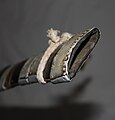Surik
| Surik | |
|---|---|

|
|
| Information | |
| Weapon type: | sword |
| Designations: | Surik |
| Use: | weapon |
| Region of origin / author: |
Timor , ethnic groups in East Timor and West Timor ( Indonesia ) |
| Distribution: | East Timor, Indonesia |
| Overall length: | up to about 100 cm |
| Blade length: | about 50 to 60 cm |
| Blade width: | about 3 cm |
| Blade thickness: | about 3 mm |
| Weight: | about 400 gr. |
| Handle: | Wood. Length about 9 cm |
| Lists on the subject | |
The surik is a traditional sword from the island of Timor , which consists of the independent state of East Timor and the Indonesian West Timor . The surik is used by ethnic groups on both sides of the border. In East Timor, it is a national symbol and featured in the country's first coat of arms. There are two different variants that differ in appearance. Today Suriks are used, among other things, in the parade uniform of the Defense Forces of East Timor .
description
- Surik type 1
The Surik Type 1 has a single-edged blade with a straight back, which runs in an S-shape at the cutting edge. The blade starts narrow at the handle and widens towards the location . Shortly before the spot, the blade is bulbous. The handle is usually made of horn and has two horn-like finishes on the pommel. At the transition from the handle to the blade, a metal clamp is attached, which is used for better attachment between the blade and the handle. The sheaths are made of wood and are flat. They are slightly bent at the local area.
- Surik type 2
The Surik Type 2 has a curved, single-edged blade. They are used exclusively in Central Timor by the Meos , a specific group of warriors. The blades often came from Dutch, Portuguese or English production. However, these blades are shortened for use in order to adapt them to the desired length. The booklet usually has a triangular shape and a hexagonal or octagonal shaft. The handle is mostly made of wood and is decorated with tufts of goat or horse hair ( Timor ponies ). In the middle of the booklet, there is an eye that has a mythological background. The sheaths consist of two wooden parts that are held together with rattan cords. The spaces between the rattan windings are often decorated with carvings. The mouth of the scabbard is always wider than the blade itself and has a rim into which the handle fits exactly. The scabbards are much longer than the blades and end in a large, flat, fan-shaped end piece. Holes are often drilled into this end piece, into which tufts of hair can be inserted, as on the handle.
literature
- Ross Bird: Inside out East Timor. Herman Press, East Melbourne 1999, ISBN 0-9577180-3-9 .
See also
Web links
Individual evidence
- ^ Albert G. van Zonneveld: Traditional weapons of the Indonesian archipelago. C. Zwartenkot Art Books, Leiden 2001, ISBN 90-5450-004-2 , p. 133.









